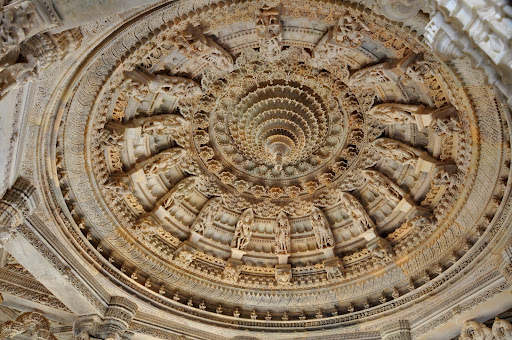Jain Temples of Rajasthan
 |
Authored By Prof. Sehdev Kumar
Book Review By Dr. Sudhir Kumar Lall
Jainism along with Buddhism and Carvakism forms the trinity of the atheistic philosophical traditions of India. However, it cosmological, cosmogonical, mythical and philosophical concepts draw heavily from the source of Vedic religion. Thus, not only the pantheon but also the principles of temple-construction and the rituals find their parallels in the other schools viz. Hinduism and Buddhism. The book "Jain Temples of Rajasthan" is a study, which helps in understanding these connections. The author, Sehdev Kumar, Professor of Environmental Studies at the University of Waterloo, Canada, has taken 20 years to produce this, visual feast, Prof. Kumar has also authored two books namely - 'The Vision of Kabir' and 'The Lotus in the Stone'. Besides, he has also ventured in the camera to produce films like 'Outside In', 'Love Suzanne', and 'Ivory Tower'.
The book under review is a picturesque journey through the temples of Dilwara and Ranakpur (both in Rajasthan). "Using these temples as nodal points for a photographic and reflective study, Prof. Sehdev Kumar explores the artistic nuances of these temples in the context of the rich tradition of temple architecture and iconography in India." The book consists of nine thematic chapters, each dealing with a specific yet related topic. It begins with the philosophical backdrop of Jainism and culminates in a holistic concept of depiction of dance, which is cosmic and individual at the same time and thus, dealing with the aspect of a Jain temple.
After discussing the basics in the first chapter, the author describes "Lotus in Art and Worship" in the second chapter titled "The Thousand-Petalled Lotus". Lotus the beautiful, mystical flower has appealed so much to the author that he has traced its philosophical, sacred and secular meanings as well as its applications through the ages. "In the Jain temples at Dilwara and Ranakpur, Lotuses have been carved on the ceilings in the navachaukis and in the marble domes of the rangamandapa, or on the ceilings in the porches and the corridors in myriad ways, and with mesmerizing magnificence and subtlety".
Chapter three "envisioning Hands" is an ode to the architects of yesteryears. Chapter four "Lotus in the Stone" deals with Jain Temples at Dilwara. The author says "A Jain temple should be seen as a symbolic representation of the Tirthankara, who, as one of those to be bowed before any one of the other Paramesthins, would deliver a sermon only inside the samavarsana, whose idol was first to appear and whose iconic symbol in the form of mula-nayaka or the main deity must be installed in the temple. The Jaina temple then, with this very idea behind its origin, went on to having a parallel and simultaneous evolution.... with the temples of co-traditions."
Dilwara houses two of the three aforementioned temples, namely the Vimalavashi and the Lunavasahi temples. They were constructed by the powerful Calukyan rulers, who ruled the Western India from 950 A. D. 1246 A. D. This period is acknowleded as an era of a great resurgence in temple building and the arts. Calukyan temples bear great resemblance to Hindu temples as far as the horizontal and vertical construction in concerned. In addition to the regular, mulaprasada (sanctum), gudhamandapa ( a closed hall) and a mukhamandapa (entrance porch to the sanctorum), the Vimalavasahi and Lunavasahi temples also sport a torana (ornamental arch) and a rangamandapa (dance pavilion).
The Vimalavashi temple was built in 1032 A. D. by Dandanayaka Vimala and is dedicated to the first Tirthankara, Adinatha. The Lunavasahi temple dedicated to the twenty-second Tirthankara, Neminatha was constructed in 1231 A. D. by Tejapala, the minister to Vaghela dynasty who assumed power from the Calukyas by about 1220 A. D. The temple at Ranakpur, dedicated to the first tirthankara, Adinatha was constructed in 1439 A. D. by an architect named Dipaka, at the instance of a devout Jaina Dharanka.
All the temples have been discussed graphically and minutely. The temple at Ranakpur is an architectural marvel "Spread over an area of 3716 square meters, comprising 29 halls and 420 pillars of which no two are alike-the caumukha temple is indeed a monumental work". James Fergusson has rightly said "...Indeed I know of no other building in India of same class, that leaves so pleasing an impression, or affords so many hints for the graceful arrangement of columns in an interior."
After discussing the factual and architectural intricacies and deliberations in details, the book in the sixth chapter moves to the "Feminine Mystique - Goddesses in Jain Temples." "The temple of Vimalavasahi through dedicated to Neminatha, is in fact a celebration of the fecundity of Ambika....Her sensuous and contented presence in this temple as also of goddess Chakresvari, Laksmi, Sarasvati, the 16 Vidyadevis and scores of sensuous dancers, fill the temple with a certain heavenly fragrance." Now come 'The Jinas and their Images' which are dealt with in the chapter titled "Across the Bhavasagar". Having discussed the iconic descriptions and manifestations of Parsvanatha, Neminatha and Shantinatha, the text pauses to apy homage to the colossal Bahubali, and the backdrop suddently changes from Rajasthan to Sravanabelgola in Karnataka, where stands the 17.6 m. high statue of Gommatesvara, chiselled out in 981 A. D. as a hallmark of sculptural skills of the Ganga dynasty. As Fergusson observes "Nothing grander or more imposing exists anywhere out of Egypt and even there, no known statue surpasses it in height".
Chapter eight deals with the depiction of nature in the Indian arts while the ninth chapter is dedicated to dance. This completes the temple in totality. All these 'Conceptual images' of Jinas, Goddesses, Nature and Dance etc got together to form a Jain temple. These temples at Dilwara and Ranakpur stand apart as marvellous examples of conglomeration of the entire Jain pantheon, their philosophy and arts. As mentioned earlier, the book is a 'visual feast'. It is like an exhibition, nay, an album of photographs and sketches, which take the reader on a 'virtual' visit to the temples. The photographs are exquisite and breathtaking. The book is a collector's pride. However, in some places the text falls inadequate. But then, the photographs distract a reader from noticing such failings.
 |
-----------------------------------------------------
Dr. Sudhir Kumar Lall, Senior Research Fellow, Kalakosa.
Published By IGNCA and Abhinav Publicatiions, New Delhi, 2001, pp.224
Price Rs.2500/-
-----------------------------------------------------
Mail to : Ahimsa Foundation
www.jainsamaj.org
R210204